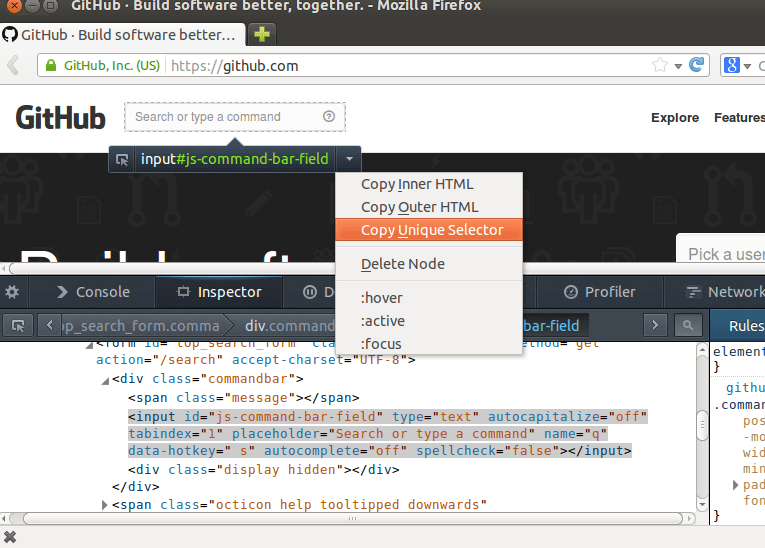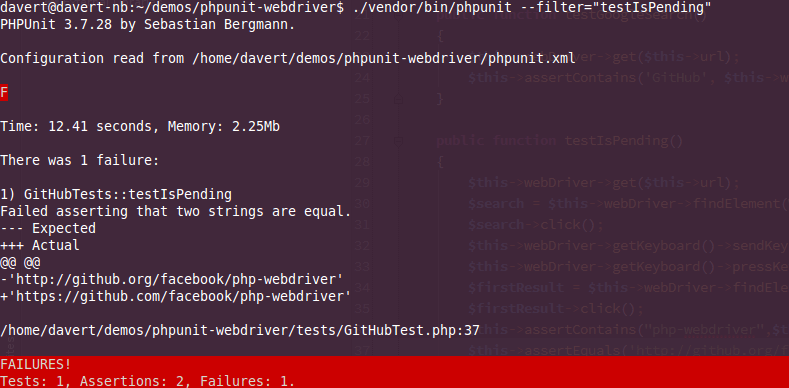In this post we will explore some basics of user acceptance testing with Selenium. We will do this with classical unit testing framework PHPUnit, web browser Firefox, and with new php-webdriver library recently developed by Facebook.
Selenium allows us to record user actions that we do inside a browser and then automate them. PHPUnit will be used to do various assertions and check them for fallacy. And php-webdriver is used to connect PHP with Selenium, in order to do browser manipulation in PHP.
Probably you know, that PHPUnit itself can do Selenium manipulations via PHPUnit. There is PHPUnit_Selenium extension you may use. We will use php-webdriver instead because this implementation is modern and its API is more clean and looks much the same way as original Java Selenium API. That’s why it is easier to learn, and much powerful, then the PHPUnit’s one. For example, it allows you use send native touch events, which is important in era of mobile-ready web applications.
Grab the tools
Let’s install all the required tools using Composer. For this we will need to have composer.json file created:
{
"require-dev": {
"phpunit/phpunit": "*",
"facebook/webdriver": "dev-master"
}
}We won’t develop any application, thus we are ok, with require-dev section only. Let’s run
php composer.phar installand grab the latest versions of both libraries. We also will need Selenium server executable as well. You need Java installed in order to run the Selenium server. You can launch it by running this:
java -jar selenium-server-standalone-2.37.0.jarAnd when the tools are prepared, let’s write some tests.
PHPUnit Test
So let’s try to test something in the web. Let’s start with something simple and well known, like Github. So, let’s create a file and call it GitHubTest.
<?php
class GitHubTests extends PHPUnit_Framework_TestCase {
}
?>As any PHPUnit test it should extend PHPUnit_Framework_TestCase (as it was mentioned, we are not using PHPUnit_Extensions_Selenium2TestCase here). For every test we will need to launch a browser, or in other words, we are starting a Selenium session. This is done by creating RemoteWebDriver instance:
<?php
class GitHubTests extends PHPUnit_Framework_TestCase {
/**
* @var \RemoteWebDriver
*/
protected $webDriver;
public function setUp()
{
$capabilities = array(\WebDriverCapabilityType::BROWSER_NAME => 'firefox');
$this->webDriver = RemoteWebDriver::create('http://localhost:4444/wd/hub', $capabilities);
}
}
?>This initialization part is taken from php-webdriver README file. We don’t have any test yet, so let’s write something a very basic. Something like: “If I open https://github.com, page title should contain GitHub”.
<?php
class GitHubTest extends PHPUnit_Framework_TestCase {
/**
* @var \RemoteWebDriver
*/
protected $webDriver;
public function setUp()
{
$capabilities = array(\WebDriverCapabilityType::BROWSER_NAME => 'firefox');
$this->webDriver = RemoteWebDriver::create('http://localhost:4444/wd/hub', $capabilities);
}
protected $url = 'https://github.com';
public function testGitHubHome()
{
$this->webDriver->get($this->url);
// checking that page title contains word 'GitHub'
$this->assertContains('GitHub', $this->webDriver->getTitle());
}
}
?>Now we execute our first test with phpunit
vendor/bin/phpunit GitHubTest.phpand in a few seconds we should see a Firefox window with Github Page in it

please notice the WebDriver text in the status bar, this tells you that this browser window is controlled by WebDriver.
In a console we will see this output:
PHPUnit 3.7.28 by Sebastian Bergmann.
.
Time: 19.44 seconds, Memory: 1.75Mb
OK (1 test, 1 assertion)We will see that test has finished, but the browser window stays opened. That is because we did not implement a tearDown method, that should be used to close the webdriver session:
<?php
class GitHubTest extends PHPUnit_Framework_TestCase {
/**
* @var \RemoteWebDriver
*/
protected $webDriver;
public function setUp()
{
$capabilities = array(\WebDriverCapabilityType::BROWSER_NAME => 'firefox');
$this->webDriver = RemoteWebDriver::create('http://localhost:4444/wd/hub', $capabilities);
}
public function tearDown()
{
$this->webDriver->quit();
}
}
?>Advanced Test
We didn’t touch any of page elements in a previous test. We just opened the page and checked its title. But the power of webdriver reveals when you want to click elements, fill forms, drag and drop elements, etc. That’s why we will write a test that demonstrates some of this features.
But how can control the browser? Should we move the mouse in order to click on element? Well, not exactly. WebDriver allows us to locate element on page by its ID, class name, element name, CSS, or XPath. Let’s list all possible locator types, taken from WebDriverBy class:
WebDriverBy::className()- searches for element by its CSS class.WebDriverBy::cssSelector()- searches for element by its CSS selector (like jQuery).WebDriverBy::id()- searches for element by its id.WebDriverBy::linkText()- searches for a link whose visible text equals to the value provided.WebDriverBy::partialLinkText()- same as above, but link partly contain the value.WebDriverBy::tagName()- search for element by its tag name.WebDriverBy::xpath()- search for element by xpath. The most complex, yet, most powerful way for element location.
To find element we should use webDriver->findElement method, with locator specified with WebDriverBy.
After the matched element is found we can click on it. Like this:
<?php
class GitHubTest extends PHPUnit_Framework_TestCase {
/**
* @var \RemoteWebDriver
*/
protected $webDriver;
public function setUp()
{
$capabilities = array(\WebDriverCapabilityType::BROWSER_NAME => 'firefox');
$this->webDriver = RemoteWebDriver::create('http://localhost:4444/wd/hub', $capabilities);
}
public function tearDown()
{
$this->webDriver->close();
}
public function testSearch()
{
$this->webDriver->get($this->url);
// find search field by its id
$search = $this->webDriver->findElement(WebDriverBy::id('js-command-bar-field'));
$search->click();
}
}
?>
We are clicking the GitHub global search field, located in top menu bar, matched by its id. By the way, how did we get the element’s id? That’s a good question. Searching for element locators is the most important task in acceptance testing. For every test we need to get the elements that are involved in it. Let’s show some simple tricks that will definitely help you in writing complex acceptance tests.
Locating Elements: Tips & Tricks
The first thing we can do is to pause the test execution. While browser window is still open, we can use it to find the locator. To pause the test execution lets write this helper method inside a test class:
<?php
protected function waitForUserInput()
{
if(trim(fgets(fopen("php://stdin","r"))) != chr(13)) return;
}
?>If we use it somewhere in our tests, PHPUnit will wait for Enter key pressed in console before going on.
<?php
public function testSearch()
{
$this->webDriver->get($this->url);
$this->waitForUserInput(); // paused
}
?>Now when the browser window is opened we are free to search for required element with no hurry. We are using Firfox Developer Tools for that. With the Element Inspector within we can point to element and get its unique CSS locator.

That is how we got search field id: #js-command-bar-field. Doing the sample steps, let’s continue writing our test and find php-webdriver repository on GitHub.
<?php
class GitHubTest extends PHPUnit_Framework_TestCase {
protected $url = 'https://github.com';
/**
* @var \RemoteWebDriver
*/
protected $webDriver;
public function setUp()
{
$capabilities = array(\WebDriverCapabilityType::BROWSER_NAME => 'firefox');
$this->webDriver = RemoteWebDriver::create('http://localhost:4444/wd/hub', $capabilities);
}
public function tearDown()
{
$this->webDriver->close();
}
public function testSearch()
{
$this->webDriver->get($this->url);
// find search field by its id
$search = $this->webDriver->findElement(WebDriverBy::id('js-command-bar-field'));
$search->click();
// typing into field
$this->webDriver->getKeyboard()->sendKeys('php-webdriver');
// pressing "Enter"
$this->webDriver->getKeyboard()->pressKey(WebDriverKeys::ENTER);
$firstResult = $this->webDriver->findElement(
// some CSS selectors can be very long:
WebDriverBy::cssSelector('li.public:nth-child(1) > h3:nth-child(3) > a:nth-child(1) > em:nth-child(2)')
);
$firstResult->click();
// we expect that facebook/php-webdriver was the first result
$this->assertContains("php-webdriver",$this->webDriver->getTitle());
// checking current url
$this->assertEquals(
'https://github.org/facebook/php-webdriver',
$this->webDriver->getCurrentURL()
);
}
protected function waitForUserInput()
{
if(trim(fgets(fopen("php://stdin","r"))) != chr(13)) return;
}
}
?>If we run this test we will see that it is failing on the last step:

That’s because we forgot that GitHub uses https by default, and GitHub is a company and not a non-profit organization (as we used to think of it, he-he). Though let’s change the expected url to ‘https://github.com/facebook/php-webdriver’ and see the test is passing.
Element Not Found
Probably we will also want to check if element is located on a page. If we were using Selenium2TestCase of PHPUnit, we would have several nice assertion that we can use just for that. In case of php-webdriver library we will need to implement them on our own. But that’s pretty easy. Php-Webdriver throws various exceptions, which we can handle and transform into PHPUnit’s assertions:
<?php
protected function assertElementNotFound($by)
{
$els = $this->webDriver->findElements($by);
if (count($els)) {
$this->fail("Unexpectedly element was found");
}
// increment assertion counter
$this->assertTrue(true);
}
?>You can create similar assertion just in the same manner.
We will use newly created assertElementNotFound method to check that there is no user avatar on “facebook/php-webdriver” page.
<?php
class GitHubTest extends PHPUnit_Framework_TestCase {
protected $url = 'https://github.com';
/**
* @var \RemoteWebDriver
*/
protected $webDriver;
public function setUp()
{
$capabilities = array(\WebDriverCapabilityType::BROWSER_NAME => 'firefox');
$this->webDriver = RemoteWebDriver::create('http://localhost:4444/wd/hub', $capabilities);
}
public function tearDown()
{
$this->webDriver->close();
}
public function testGitHubHome()
{
$this->webDriver->get($this->url);
// checking that page title contains word 'GitHub'
$this->assertContains('GitHub', $this->webDriver->getTitle());
}
public function testSearch()
{
$this->webDriver->get($this->url);
// find search field by its id
$search = $this->webDriver->findElement(WebDriverBy::id('js-command-bar-field'));
$search->click();
// typing into field
$this->webDriver->getKeyboard()->sendKeys('php-webdriver');
// pressing "Enter"
$this->webDriver->getKeyboard()->pressKey(WebDriverKeys::ENTER);
$firstResult = $this->webDriver->findElement(
// some CSS selectors can be very long:
WebDriverBy::cssSelector('li.public:nth-child(1) > h3:nth-child(3) > a:nth-child(1) > em:nth-child(2)')
);
$firstResult->click();
// we expect that facebook/php-webdriver was the first result
$this->assertContains("php-webdriver",$this->webDriver->getTitle());
$this->assertEquals('https://github.com/facebook/php-webdriver', $this->webDriver->getCurrentURL());
$this->assertElementNotFound(WebDriverBy::className('avatar'));
}
protected function waitForUserInput()
{
if(trim(fgets(fopen("php://stdin","r"))) != chr(13)) return;
}
protected function assertElementNotFound($by)
{
$els = $this->webDriver->findElements($by);
if (count($els)) {
$this->fail("Unexpectedly element was found");
}
// increment assertion counter
$this->assertTrue(true);
}
}
?>Refactoring
To clean up some things we will separate test methods and support methods. It is a good idea to move custom assertions into trait: WebDriverAssertions. And the pause switcher waitForUserInput can be moved into WebDriverDevelop trait. We can enable this trait in a test class, when we develop a test, and turn it off once we finished.
The complete demo project, after this basic refactoring, you can find on GitHub.
And what about Codeception?
So you did notice that this is Codeception blog. But we didn’t use Codeception framework at all in this tutorial. Sure, we need to mention, that Codeception includes php-webdriver library and WebDriver module out of the box starting from version 1.7. In Codeception you can perform all the web manipulations in a much simpler manner using the WebGuy APIs. If you use Codeception you don’t need to implement your own WebDriver assertions nor write boilerplate code.
Conclusions
No matter you are using Codeception or not it is a good idea to understand how to perform browser based acceptance testing using just the php-webdriver by itself. Php-webdriver library provides very clean and flexible APIs you will enjoy working with.
PHP is a language popular for web development, but not for web testing. Test automation engineers prefer Java and Ruby over it. And there is a serious reason for that. There is no such thing like “official Selenium bindings” for PHP, i.e. there is no Selenium client library for PHP created by Selenium team. Developers of php-webdriver get very close to the official Selenium client APIs. That’s why you should use php-webdriver - it really feels and works like native and official Selenium libraries. That is especially important if you have an experience writing acceptance tests in Java or Ruby. Moving to PHP is not that hard, when all the APIs are the same.

 Codeception_
Codeception_

